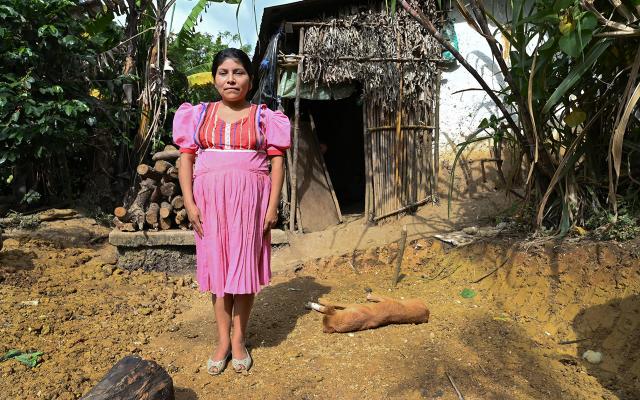
The climate crisis is already forcing millions of people from their land and homes, and putting many more at risk of displacement in the near future. Supercharged storms, more intense and prolonged droughts, floods, rising seas and other climate-fueled disasters such as cyclones or wildfires all worsen the lives of vulnerable people and increase the likelihood of being forced to move.
-
People are seven times more likely to be displaced by cyclones, floods or drought than by earthquakes and volcanic eruptions, and three times more likely than by conflict.
While no person is immune to such disasters, people in poor countries – and particularly women - are most at risk. They often live in rural areas with poor infrastructure and limited access to healthcare and education. Many of them depend on farming or fishing and they are unlikely to have insurance or savings to help them rebuild their livelihoods after an emergency. When crops get destroyed and livestock dead, they have little choice but to abandon their ancestral lands and migrate to survive.

Women are often amongst the last to leave when more extreme or erratic weather makes it harder for families to put food on the table. They stay at home looking after their children or sick relatives while men leave –sometimes for days - in search of any income or food, becoming the only ones providing for the family and, consequently, facing more difficulties and struggles.
When women and children are forced to leave home and find shelter in displacement camps, they face unsafe living conditions, making them more vulnerable to violence and abuse.
Climate migrants: voices from the field
Climate displacement has many faces and it happens everywhere. Meet some of the people who are bearing the brunt of its impacts and are fighting each day to have a future.
"The rains are less and less ….", Amina Ibrahim - Ethiopia
Pastoralist families in the Horn of Africa are enduring a severe drought right now, following a series of intense droughts that struck the region in 2011 and 2017. Many of them depend on humanitarian aid to survive.
“The rains are less and less …. I have no idea what is behind this, but I can tell you that there is a lack of rainfall and there is hotter and hotter weather.”
Amina Ibrahim, 50, fled her home in Qararo in 2017 with her 12 children, after their animals died and an outbreak of water-borne diarrheal disease (most likely cholera) started killing people.
Since then they have been living in a makeshift shelter in Gunagado, where Oxfam, other organizations, and the Ethiopian government have been helping her with clean water, food, latrines, occasional cash, and hygiene items such as soap.
"We have lost 100 meters of our land here", Maria Tekaie - Kiribati (Pacific Islands)
For Pacific Islander peoples, the climate crisis is a very real, present and deepening reality. In the atoll nations of Kiribati, Tuvalu and the Marshall Islands, rising seas and higher storm surges are already swallowing land and homes and contaminating scarce water supplies.

“We are very sad because we know that the sea will never stop eating our land. So maybe we don’t have much hope in this part of the island because the sea will just keep on eating it.”
Maria, 65, from Tebunginako village, Abaiang Island (Kiribati) has had to move several times with her family. Saltwater intrusion and intense coastal erosion have taken away much of their land and destroyed their food gardens.
“We love our village but already we have lost 100 meters of our land here. We are lucky that we own the land from there to there, but any further than that and it’s not our land anymore. Maybe we will have to move somewhere else, to another part of the island. But we just love it here.”
"We spent almost eight days enduring starvation", Mariana López - Guatemala’s Dry Corridor
An El Niño period, supercharged by the climate crisis, has led to severe drought and erratic rains across Central America’s Dry Corridor – particularly Guatemala, Honduras, and El Salvador. Longer drought periods have devastated crops and left families with little food and no means of living, which contributed to worsening the already critical children's malnutrition rates. Now, more and more people have no other option than making the long and dangerous journey to Mexico or the United States in the hope of finding work and feeding their families.

“He left because of necessity. We could not find food. We spent almost eight days enduring starvation.”
Mariana López lives in the community of Naranjo, in Guatemala’s Dry Corridor with their children. When the persistent drought ruined their harvests and there were no job opportunities nearby, Marian’s husband and son were forced to migrate to the United States. They had to sell their land and take on debt to pay for the journey.
Their lives have improved a bit now that her husband can send some money. With the little amount she receives, she can pay off the debt and, once in a while, they can afford to put sugar in their coffee, wash clothes with soap rather than with just water, and put beans in the corn tortillas that most days they have to eat empty.
Over the last year, Oxfam has worked with partners to support 10,000 people across the Dry Corridor. For example, we supported rural communities to adapt to the dry conditions using drought-resistant crops as well as providing clean water and sanitation equipment and food supplements for malnourished children.
Photo credits: Pablo Tosco/Oxfam, Ula Majewski/OxfamAUS and Valerie Caamaño/Oxfam
